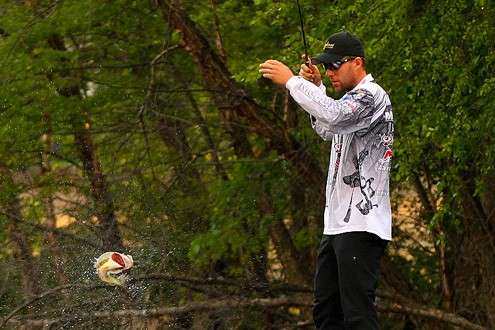
LA CROSSE, Wis. — Local fly fishers know it as "the Hex hatch." And when compared to some in this area, the Hexagenia Limbata mayfly hatch that began Saturday night and continued into Sunday wasn't newsworthy — nothing like the hatches that have required snowplows to clear them off bridges, or the ones so intense they showed up on Doppler radar.
But this one was enough to leave some anglers feeling hexed on the final day of the Bassmaster Elite Series Mississippi River Rumble.
"I would have given a hundred-dollar-bill for one mayfly (lure) today," said Bill Lowen of Brookville, Ind., who finished seventh with 57 pounds, 10 ounces over the four-day tournament.
Lowen had the second-largest five-bass limit of the 12 finalists. With 15-1 on the day, he finished 4 pounds, 10 ounces behind winner Todd Faircloth of Jasper, Texas. But Lowen thought he could have done much better, with the right lure.
"I pulled up on this spot and saw all these bugs coming down the current seam," he said. "It looked like trout coming to the surface, so I stopped there for a minute to watch."
At first, Lowen saw only six- to eight-inch smallmouth bass rising to sip these big mayflies off the surface. Then he glanced further down the current seam, where the mayflies were piling up, and couldn't believe his eyes.
"I'm talking fours-, fives and maybe some six-pounders," he said. "You can see their brown-and-black backs and all the bars on their sides. I start trying everything I can to get them to bite."
Lowen caught one 3 ½-pounder on a tube bait, but couldn't coax another strike.
"A hundred casts later, after I tried everything I could think of, I finally said, 'I've got to go,'" Lowen recalled. "I may never be in that situation ever again, but I'm going to have something that looks like a big mayfly. I was looking at 20 pounds.
"I've never seen anything like it. It was incredible."
Lowen did catch plenty of smallmouth bass Sunday, just none of those big ones that were dieting strictly on mayflies.
"I probably caught 20 smallmouth," he said. "They'd shake their head when I got them in the boat and cover the front deck with mayflies."
The Hexagenia Limbata mayfly species is the second-largest of these aquatic insects in North America. They're also called the "Giant Michigan Mayfly"; they're over an inch long. In recent years this stretch of the Mississippi River near La Crosse has made headlines for its incredible "Hex hatches." On May 29, 2010, the hatch was so thick it showed up on Doppler weather radar. In recent years, the city has brought out snowplows to clear bridges and road where the mayflies piled up.
The good news is that mayflies of any species are water quality indicator. These massive hex hatches are a relatively recent, and therefore a sign of improving water quality in the Mississippi River.
Mayflies spend most of their lives in the larval stage, buried on the river bottom. Their adult life consists of rising to the water surface and flying long enough to mate. Adult females lay eggs over water, and the life cycle begins again. Adult mayflies don't eat anything — they just have sex and die, sometimes in a matter of hours, a few days maximum.
Aaron Martens was ready to kill some mayflies Sunday.
"I'm about ready to eat that one, just to keep a bass from eating it," said Martens at one point in a long, frustrating day. "Stupid mayflies!"
The mayfly hatch hurt Martens more than some others because he was targeting deeper fish. He concentrated on a section of Black River where bass were holding in 10- to 20-feet of water. Once these giant mayflies came on the scene, the bass moved accordingly.
Martens was in second place, only seven ounces behind Faircloth, after three days. He finished fifth after catching only 10-13 Sunday, by far his worst day.
"It really scattered the fish," Martens said. "They were all up off the bottom. It was frustrating, really frustrating."
It's difficult to imagine a bass feeding on a bug, when bigger meals are all around them, like in Martens' area of Black River, where schools of gizzard shad were abundant.
But an easy snack get preference over a hard-earned meal, especially when the snacks are as big as these mayflies.
"It's like eating a Cheez-It," Martens said. "They feel like we would after eating a box of Cheez-Its."
And that left them too full to be interested in anything Martens had to offer Sunday.
